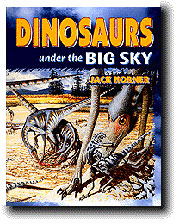Dinosaurs Under the Big Sky
By Jack Horner
Mountain
Press, Publishing Company Inc. 2001, 208 pp.
ISBN: 0-87842-445-8 $20

Dinosaurs Under the Big Sky
|
 |
As a high-school student, Jack Horner searched, unsuccessfully, for books that would reveal the location of Montana fossils and teach readers how to identify them. It's a void that time never filled, according to Horner, now curator of paleontology at Montana State University's Museum of the Rockies. This volume, he says, fills the empty space. Moreover, he dubs it a book for old-hand fossil collectors and anyone with an interest in Montana dinosaurs. Horner doesn't define the knowledge level of his intended audience, but his book provides a good foundation for both veteran and neophyte amateur fossil hunters. Often, his teachings have universal application.
Chapter five and Horner's second appendix represent the meat of Horner's book. These are his field-guide sections, although he never calls them that. Here, he describes Montana's dinosaurs and accompanies his descriptions with excellent sketches and photos. He explains differences between adult and juvenile fossils and why some might be impossible to differentiate from others–details applicable to findings anywhere. He identifies various geological formations, their composition and color, what formations lie above and beneath, and where they are best seen. He tells whether the fossil beds are easy or difficult to excavate–good information for some who might be unprepared to explore specific areas.
Horner doesn't stop there. He explains how one might distinguish between rocks–pseudofossils–and the real thing, which is not easy even for experienced paleontologists. He provides instructions for the collection process, although he recommends that amateurs secure the help of experienced paleontologists to unearth their findings. Finally, he explains how museums identify, preserve, and store fossils, and he lists the important details that should be included with any explorer's field notes. Again, much of this information applies to any fossil findings, not just those exhumed in Montana.
Still, Horner could improve his book, although its flaws are not major. Following usual practice, Horner places his appendices at the back, but his second appendix, with its focus on the dinosaur skeleton, should be an early chapter. When Horner's readers encounter sketches, photos, and references to skeletal parts in early chapters, they have not had the benefit of descriptions, sketches, and explanations provided in his second appendix. Minimally, his first chapter should tell readers that they could enhance their journey through his book by first becoming acquainted with Appendix II. It's an excellent mate for his chapter-five field guide and particularly helpful for those lacking the foundation that Horner seeks to provide. Less serious but still a shortcoming, Horner's second appendix includes four skull sketches with matching legends, but Horner fails to locate some skull legends-basiooccipital and prefrontal-on his sketches.
Another minor shortcoming is the omission of terms in his glossary. Geology and paleontology often intertwine, and Horner links the two disciplines so that readers understand the relationship between geological formations and the fossils they hold. Still, he uses unconformity, neural spine, hypsilophodontid, and other terms without explanation. Not until the end of his book does he equate neural arch, a glossary term, with neural spine. Trained paleontologists might not need the additional glossary entries, but Horner directs the book at amateurs, too, and his glossary should account for their inexperience.
Still, Horner's prose is clear. Most terms are included in his glossary or explained. If you're a new fossil hunter and hope to use this volume as a primer, it will work. You might trudge along at times, the result of new terminology, but if you're resourceful, you'll soon find this volume helpful. If you're a veteran fossil collector, you're likely to benefit from Horner's strong knowledge as well. If you want more, Horner has taken care of that, too, with an eleven-page bibliography for additional reading.
Copyright: Palaeontologia Electronica, 30 August 2002